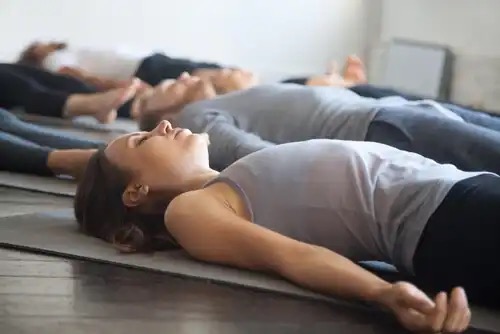Breathing Exercises for Managing Stress

Breathing exercises are a simple, fast, and very effective measure for managing stress and anxiety. This is because the first thing that happens when you’re stressed is that your heart rate increases. It’s due to the action of the stress hormone, cortisol. Consequently, your breathing also accelerates.
Breathing exercises can help you get back on track. Indeed, measured breathing slows down your heart rate. This also helps mitigate your feelings of fear and tension that tend to accompany stress.
You don’t need to do an entire relaxation session to achieve this. In fact, it’s enough to just do the breathing exercises for five or ten minutes. Indeed, breathing exercises are extremely practical techniques that you can carry out anywhere and in practically any situation.
Here are some breathing exercises to practice when you’re stressed.
“Let thy food be thy medicine and medicine be thy food.”
-Hippocrates-

Equal breathing exercises
Equal breathing is one of the breathing exercises used in yoga. The goal is to produce a balance between body and mind. You could say it’s one of the most basic forms of breathing, as well as one of the most effective.
You simply breathe in while counting to four, then breathe out counting to four again. You should breathe through your nose. This kind of breathing is said to be most effective before bed. It’s like a pleasant call to sleep.
Diaphragmatic breathing exercises
Diaphragmatic or abdominal breathing exercises are ideal for intense stress. For example, before an exam or a public speech. They’re also useful in situations of great excitement or where you got news you’re finding difficult to process.
The technique is as follows. Place one hand on your chest and the other on your abdomen. Breathe deeply through your nose. Then, pretend you’re “swallowing” the air. If you succeed, you’ll feel your abdomen expand as well as your diaphragm area. Repeat this, six to ten times per minute, for ten minutes.
Alternate nostril breathing
This technique is recommended for when you’re trying, unsuccessfully, to find a solution for a problem. Also, when you’re unable to concentrate and can’t come up with any good ideas no matter how hard you try.
The technique is as follows. With your thumb, close off your right nostril. Then, inhale as deeply as you can. When you’ve reached your limit, repeat with the other nostril. Keep the process going for about five minutes, alternating the nostrils.
Progressive muscle relaxation
This is a technique to try when you feel nervous or restless. It’s highly recommended for moments of high anxiety when you feel threatened but don’t really know why. It also helps when you’re trying to fall asleep. In fact, as the name suggests, it leads to progressive relaxation.
The goal is to tense each muscle while inhaling through the nose and then relax them, exhaling through your mouth. Close your eyes and start with your feet. Think about your feet and tense them as much as you can while inhaling and counting to five. Then, exhale and relax, while counting up to five again. Continue the process with your legs, buttocks, abdomen, arms, hands, neck, jaw, and eyes.

Awakening breathing
This is a slightly more complex breathing exercise. You need to have already mastered diaphragmatic breathing to do this. You breathe in slowly and deeply, bringing air into your abdomen. Then, you exhale as quickly as you can. The idea is to increase the pace until you can take about ten breaths of this type per minute.
Sometimes, stress manifests itself as psychological exhaustion, apathy, and despair. This type of breathing is suitable for these kinds of circumstances. It wakes you up and helps you to see everything in a more optimistic and energetic way. This exercise is also useful when you feel extremely tired.
As you can see, all these breathing exercises are simple. They don’t take much time, yet they’re able to transform a bad experience into a good one. For this reason, don’t hesitate to put them into practice, particularly at times when you feel you’ve lost your inner peace due to stress.
Breathing exercises are a simple, fast, and very effective measure for managing stress and anxiety. This is because the first thing that happens when you’re stressed is that your heart rate increases. It’s due to the action of the stress hormone, cortisol. Consequently, your breathing also accelerates.
Breathing exercises can help you get back on track. Indeed, measured breathing slows down your heart rate. This also helps mitigate your feelings of fear and tension that tend to accompany stress.
You don’t need to do an entire relaxation session to achieve this. In fact, it’s enough to just do the breathing exercises for five or ten minutes. Indeed, breathing exercises are extremely practical techniques that you can carry out anywhere and in practically any situation.
Here are some breathing exercises to practice when you’re stressed.
“Let thy food be thy medicine and medicine be thy food.”
-Hippocrates-

Equal breathing exercises
Equal breathing is one of the breathing exercises used in yoga. The goal is to produce a balance between body and mind. You could say it’s one of the most basic forms of breathing, as well as one of the most effective.
You simply breathe in while counting to four, then breathe out counting to four again. You should breathe through your nose. This kind of breathing is said to be most effective before bed. It’s like a pleasant call to sleep.
Diaphragmatic breathing exercises
Diaphragmatic or abdominal breathing exercises are ideal for intense stress. For example, before an exam or a public speech. They’re also useful in situations of great excitement or where you got news you’re finding difficult to process.
The technique is as follows. Place one hand on your chest and the other on your abdomen. Breathe deeply through your nose. Then, pretend you’re “swallowing” the air. If you succeed, you’ll feel your abdomen expand as well as your diaphragm area. Repeat this, six to ten times per minute, for ten minutes.
Alternate nostril breathing
This technique is recommended for when you’re trying, unsuccessfully, to find a solution for a problem. Also, when you’re unable to concentrate and can’t come up with any good ideas no matter how hard you try.
The technique is as follows. With your thumb, close off your right nostril. Then, inhale as deeply as you can. When you’ve reached your limit, repeat with the other nostril. Keep the process going for about five minutes, alternating the nostrils.
Progressive muscle relaxation
This is a technique to try when you feel nervous or restless. It’s highly recommended for moments of high anxiety when you feel threatened but don’t really know why. It also helps when you’re trying to fall asleep. In fact, as the name suggests, it leads to progressive relaxation.
The goal is to tense each muscle while inhaling through the nose and then relax them, exhaling through your mouth. Close your eyes and start with your feet. Think about your feet and tense them as much as you can while inhaling and counting to five. Then, exhale and relax, while counting up to five again. Continue the process with your legs, buttocks, abdomen, arms, hands, neck, jaw, and eyes.

Awakening breathing
This is a slightly more complex breathing exercise. You need to have already mastered diaphragmatic breathing to do this. You breathe in slowly and deeply, bringing air into your abdomen. Then, you exhale as quickly as you can. The idea is to increase the pace until you can take about ten breaths of this type per minute.
Sometimes, stress manifests itself as psychological exhaustion, apathy, and despair. This type of breathing is suitable for these kinds of circumstances. It wakes you up and helps you to see everything in a more optimistic and energetic way. This exercise is also useful when you feel extremely tired.
As you can see, all these breathing exercises are simple. They don’t take much time, yet they’re able to transform a bad experience into a good one. For this reason, don’t hesitate to put them into practice, particularly at times when you feel you’ve lost your inner peace due to stress.
All cited sources were thoroughly reviewed by our team to ensure their quality, reliability, currency, and validity. The bibliography of this article was considered reliable and of academic or scientific accuracy.
- Dennison, P. E., & Dennison, G. E. (2005). Cómo Aplicar Gimnasia Para el Cerebro: Técnicas de Autoayuda Para la Escuela y el Hogar. Editorial Pax México.
This text is provided for informational purposes only and does not replace consultation with a professional. If in doubt, consult your specialist.







